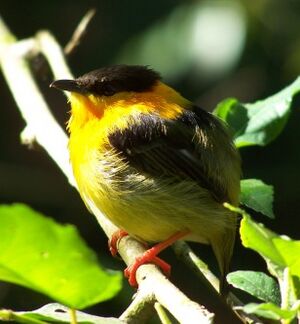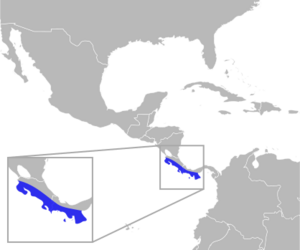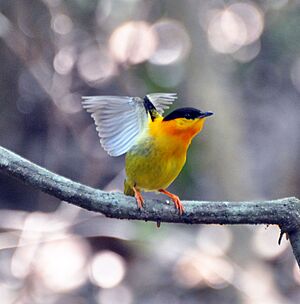Orange-collared manakin facts for kids
Quick facts for kids Orange-collared manakin |
|
|---|---|
 |
|
| Male in adult plumage (>2 years old) | |
| Conservation status | |
| Scientific classification | |
| Genus: |
Manacus
|
| Species: |
aurantiacus
|
 |
|
The orange-collared manakin (its scientific name is Manacus aurantiacus) is a small, colorful bird. It belongs to the manakin family. You can find it living only in Costa Rica and western Panama. It likes to live in forests, bushy areas, and even some farms.
This bird is small and a bit plump, usually about 10 centimeters (4 inches) long. Male orange-collared manakins are very colorful! They have a black cap, black wings, and a black tail. Their back is also black in the middle. But their head, neck, chest, and upper back are bright orange! Their lower back is olive-green, and their tummy is yellow. Females are mostly olive-green with yellow bellies. They look a lot like female white-collared manakins.
When it's time to find a mate, male manakins gather on the forest floor. They perform special dances called "lekking" to attract females. This bird is quite common in its home area. Because of this, the International Union for Conservation of Nature says it is a "least concern" species. This means it is not currently in danger.
What Does It Look Like?

The orange-collared manakin is a small bird with a short tail. Like its relatives, it has a strong, hooked beak. Its legs are orange, and the males have very bright feathers. This bird is typically 10 centimeters (4 inches) long. It usually weighs about 15.5 grams (about half an ounce).
The adult male has a black cap on its head. Its wings and tail are also black. There is a black band across the middle of its back. The rest of its head, neck, chest, and upper back are bright orange. Its lower back is olive-green, and its belly is a bright yellow.
The male's wings are very special. The five outer flight feathers are very narrow on their outer half. The inner flight feathers are thicker and curved. Only male white-collared and golden-collared manakins share this feature. The male's call is a clear cheeuu. They also use their special wings to make a loud snap sound. It sounds like a twig breaking! They can also make rustling and whistling noises with their wings.
Female manakins and young males are olive-green. They have a yellow belly. They look very similar to female white-collared manakins. However, their living areas do not overlap. First-year males have a golden color on their chest.
Where Do They Live?
This bird lives in the lowlands and foothills. You can find it on the Pacific side of Costa Rica and western Panama. It lives in areas up to 1100 meters (3,600 feet) high. On the Caribbean side of tropical Central America, you will find the similar white-collared manakin. Further east, in northwestern Colombia, lives the golden-collared manakin.
The orange-collared manakin likes semi-open moist forests. It also lives in tall, new growth forests. You can find it in shady plantations and even gardens.
Life Cycle and Behavior
Like other manakins, this species has a very interesting way of finding a mate. Males gather in a special area called a lek. Each male clears a small patch of forest floor. This patch can be up to 120 centimeters (4 feet) wide. It clears the ground to bare earth.
Then, the male leaps back and forth between thin, bare sticks. While doing this, it makes a loud wing snap. When a female comes to watch, the males jump together. They cross over each other above the bare display area. The males also puff up their throat feathers to make a "beard."
The female builds a shallow, cup-shaped nest. She places it 0.5 to 2.5 meters (1.5 to 8 feet) high in a horizontal tree fork. She lays two gray eggs with brown speckles. The female does all the work alone. She builds the nest and sits on the eggs for 18 to 21 days. She also takes care of the young birds by herself. Manakins do not stay together as pairs.
The orange-collared manakin eats low in the trees. It mostly eats fruit and some insects. It picks these from the leaves while flying.
Conservation Status
This bird lives in a somewhat small area. However, it is quite common within that area. Experts believe its population is slowly decreasing. This is because its habitat is being destroyed. Even so, the International Union for Conservation of Nature has said the bird is of "least concern". This means it is not currently at risk of disappearing.


